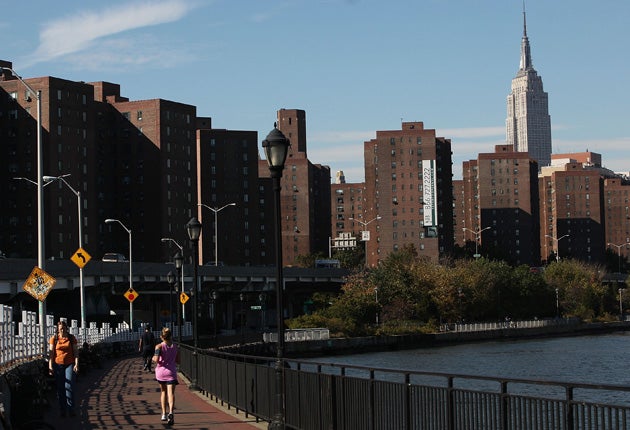Collapse of Manhattan's $5bn answer to rent crisis
Stuyvesant Town affordable-housing complex falls victim to the recession

Your support helps us to tell the story
From reproductive rights to climate change to Big Tech, The Independent is on the ground when the story is developing. Whether it's investigating the financials of Elon Musk's pro-Trump PAC or producing our latest documentary, 'The A Word', which shines a light on the American women fighting for reproductive rights, we know how important it is to parse out the facts from the messaging.
At such a critical moment in US history, we need reporters on the ground. Your donation allows us to keep sending journalists to speak to both sides of the story.
The Independent is trusted by Americans across the entire political spectrum. And unlike many other quality news outlets, we choose not to lock Americans out of our reporting and analysis with paywalls. We believe quality journalism should be available to everyone, paid for by those who can afford it.
Your support makes all the difference.It was the most expensive residential property deal ever. It was among the most controversial. And now it is the most disastrous.
New York's sprawling Stuyvesant Town complex, an 11,000-apartment bulwark of affordable housing amid Manhattan's skyrocketing rents, has been handed over to its creditors, after its owners failed to keep up debt repayments on their $5.4bn (£3.3bn) boom-time acquisition.
When a consortium led by the property giant Tishman Speyer won an auction for the complex on Manhattan's East Side in 2006, it unveiled plans to convert large numbers of the apartments into luxury homes. This was, after all, prime real estate, overlooking the East River, in a city where rents were being pushed ever higher by the economic boom. Stuy Town's residents, though, benefited from historic commitments to keep rents below market rates, and they had other ideas.
The legal stand-off between the two sides might have been enough on its own to wreck Tishman Speyer's plans, but then came the calamity on Wall Street and the recession, which threw the New York property market into turmoil. The valuation being put on Stuy Town (and the adjacent Peter Cooper Village, which was also included in the deal) is now less than $2bn.
The decision to turn the property over to its creditors represents a huge blow to the prestige of Tishman Speyer, a firm with a penchant for Manhattan landmarks, whose portfolio also including the Chrysler Building and the Rockefeller Centre. It is a blow, too, to the prestige of its founder, Jerry Speyer, one of the city's most prominent philanthropists and political players.
The Stuy Town wipeout has seemed inevitable for many months, as Tishman Speyer faced a deadline to repay a large portion of the $4.4bn in debt it had taken on for the property. It formally defaulted on that debt last month.
"We have spent the last few weeks negotiating in good faith to restructure the debt and ownership," the developer said in a statement. "Over the last few days, however, it has become clear to us through this process that the only viable alternative to bankruptcy would be to transfer control and operation of the property, in an orderly manner, to the lenders and their representatives.
"A battle over the property or a contested bankruptcy proceeding is not in the long-term interest of the property, its residents, our partnership or the city," they said.
That, at least, raised a sigh of relief from residents, who feel that Tishman Speyer has been battling for quite long enough. Residents' groups opposed the sale from the start, fearing that the unique history and culture of the complex was about to be crushed in the interests of turning a quick profit.
The 80-acre site had been developed after the Second World War as affordable housing for veterans. It was only by promising to keep rents low that MetLife, an insurance group, won permission – and tax breaks – to build the complex. More than six decades later, the apartments there offer working folk, including nurses, teachers and firefighters, sanctuary from the rising rents that all but banished the low-paid from New York's other boroughs.
A final death knell for Tishman Speyer's ownership came in October when tenants groups won a court ruling that the developer was improperly charging market rents on thousands of properties. It should not have raised the rents because it was receiving tax breaks to pay for upgrading the properties, the New York Supreme Court said.
The consortium that bought Stuy Town from MetLife in 2006 also included the Wall Street fund management giant BlackRock and a host of smaller pension funds and other investors. Tishman Speyer invested only a reported $112m of its own money.
Among those facing losses is the Church of England, which is believed to have put in tens of millions of pounds. "Even God losing money on Stuy Town," the headline writers at Curbed. com, an irreverent New York real- estate blog, noted last autumn.
Join our commenting forum
Join thought-provoking conversations, follow other Independent readers and see their replies
Comments